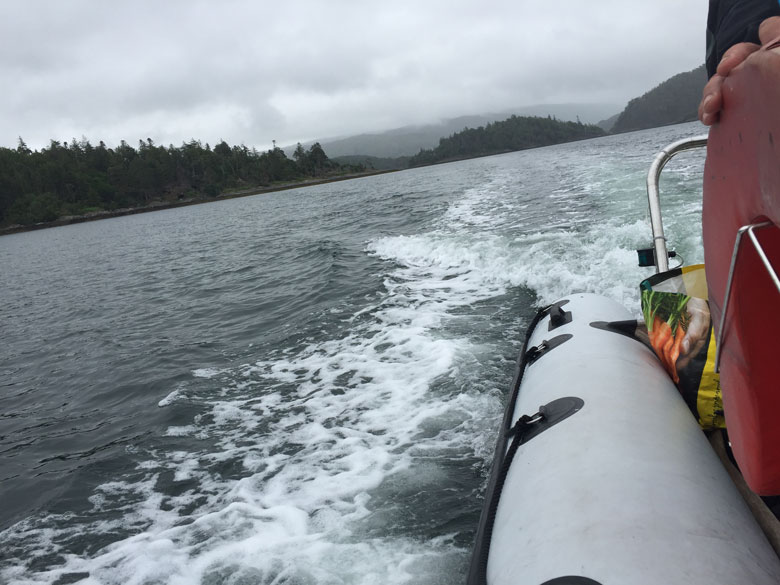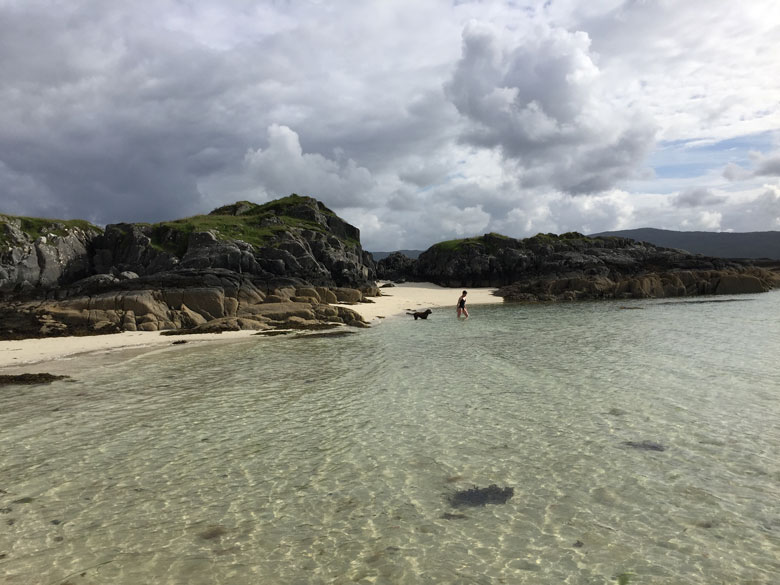Mussel beach

On an off-grid escape to a Scottish island, Louise Bell and Christian Smith discover that wild mussels are delicious, abundant and easy to find – if you know where to look.
The trick to foraging for mussels, or indeed for anything, is to pick the right spot. And spots don’t come much righter than Eilean Shona. An island 2.5 miles long and 1.5 wide off the west coast of Scotland, it slots so neatly into the meandering mainland that you might need to look twice at the map to see that it’s detached at all. But if you ever want to get away from it all, it’s a magical place apart.
We’ve been a couple of times in the last decade or so. It’s been written about quite a bit in that time, but it still feels like our secret. The 15-minute boat journey across Loch Moidart passes the floating, moody ruin of Castle Tioram, adding to the fairytale atmosphere. Eilean Shona dubs itself Neverland Found, and it’s fair comment. JM Barrie visited in the 1920s and is said to have penned the screenplay to Peter Pan here. “A wild rocky romantic island it is too,” he wrote in a letter.
It’s still much the same today. It has no roads, no mobile phone signal. At South Shore cottage, where we stay, there’s no electricity either. The gas lights fire up with a gentle PUH! and give out a soothing hiss and a lovely mellow glow. The water runs fresh from the burn, a little brown from the peat, but no less delicious for that: it’s heated (eventually) by the same coal-burning stove that keeps the sitting room toasty. The view from the dining-room table looks across to Rum and Eigg, lined up like notched rifle sights, and just a short walk away through the bracken and fields of yellow irises is Shoe Bay, a small, crescent beach of white sand. It’s simple, cosy, perfect.

There’s everything and nothing to do here, so visitors spend their time variously walking, reading, writing, painting, bird-watching, wildlife-spotting, kayaking, fishing and, as we discovered from dipping into the volumes of visitors’ books, foraging for wild mussels. Which is where we got the idea. Never done it, we thought; worth a try. And it was a revelation.
Clearly, we were no experts, but, as it turned out, we didn’t have to be. Mussels cluster, we discovered, choosing the spots that they think are just right. Having looked here and there and found just the odd shell, mostly empty otter leavings, we followed the directions in the visitors’ book to what you might call mussel beach – and there they were. Every rock was heaving. Taking care only to choose clumps still covered with water (very important), we filled our bag and went home, making another discovery along the way: mussels are heavy.
They can take some cleaning, too. We’ve since read up on the topic in the excellent Edible Seashore, River Cottage Handbook #5, by John Wright. He says that you just need to give them “a good scrub under running water to remove anything you don’t like the look of, and debeard them by pulling away the byssal threads”. We went further and scraped all the barnacles away too, concerned that they might be repositories of grit – a surprisingly major undertaking that you may well want to do without. The barnacles “will just make your dinner seem all the more authentically wild,” writes John. Note to self: read the book first next time.

John also points out that mussels in Scotland are owned by the Crown and, technically at least, it is illegal to gather them without permission – but, fortunately, collecting for personal use is tolerated. Phew. Another issue that deserves rather more thought is safety. Food poisoning is a very real concern with wild mussels. As bivalves, they are filter feeders, so if there is anything nasty in the many litres of sea water that pass through them every hour – such as bacteria, viruses, algae or chemicals – they will take it up.
Which brings us back to where we came in: picking the right spot. The waters of Loch Moidart are pristine; bell clear and constantly refreshed by the tide that races past Eilean Shona. (It’s wonderful for swimming too, though bracing. A local tip: “Wear a swimming cap – if your head is warm you have nothing to fear.”) If you’re thinking of foraging yourself, look for clean water, without outflows, agricultural runoff, litter and so forth. Also avoid spring and summer, when bacteria are at their peak and algal blooms most likely – these can happen even in the purest Scottish waters, particularly in a warm summer. Autumn is a perfect time, when the mussels are at their plumpest, ready for winter.

John Wright also suggests purging your catch in well-aerated sea water for a few hours. “Bivalves open up their shells in water and will quickly drown once they have used up the dissolved oxygen,” he writes. “I use big, shallow trays for the purpose so that oxygen can be easily dissolved from the air, and I lay the shellfish no more than one deep. I keep the water cool and splash it about a lot for the same reason, changing it at least once.” We didn’t – but we probably would give it a go next time. And, finally, always make sure you cook your mussels thoroughly and only eat those that have opened afterwards – never, ever one that remains shut. Note that even if you follow all these rules, there is still a risk and it’s entirely up to you to decide whether it’s worth taking.
So if that’s the risk, what’s the reward? Hand on heart, we can honestly say that these were the best mussels we have ever tasted. Maybe it’s because this spot is particularly special. Maybe it’s because we foraged them ourselves, or that we collected them that very morning. Whatever the reason, they were gloriously plump, rich and soft – so delicious and abundant that we could literally eat them three times a day, including with eggs for breakfast. And if that doesn’t set you up for the day, nothing will.
Wild mussels with bacon and beer

This recipe was born of necessity – after a week cut off from the mainland, the fridge was looking pretty bare – but was scrumptious nonetheless. Feel free to substitute garlic or onion for the leeks, chorizo for the bacon and white wine or stock for the beer. Precise quantities are not important here, but a hunk of good bread to soak up the juices is pretty much non-negotiable. If you’re away on an island with nothing much else to do, there’s no excuse not to make your own.
Ingredients
- Mussels, thoroughly scrubbed and debearded
- Oil and/or butter
- A couple of rashers of bacon
- A large leek
- Beer – we used the remnants of our mini-keg of Jarl, a light golden beer from the Fyne Ales micro-brewery
Method
- Heat the oil and/or butter gently, in as big a pan as you can muster (we had to cook ours in batches). Add the chopped bacon and leeks, and leave to soften so that the fat renders out of the rashers.
- Throw in the cleaned mussels, well drained, and add the beer. You don’t need to cover the mussels or even come halfway up the side – but you do need enough liquid to generate a decent amount of steam (and, of course, a decent amount of juice to do justice to that bread).
- Clamp on the lid and leave to bubble and steam until the mussels are open.
- Serve in deep bowls, with a good ladleful of the cooking juices poured over.





